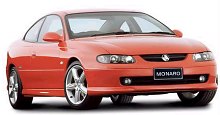 You
won’t be wrong calling it a Commodore coupe. Everybody knows it is a
coupe
version of Commodore, just like the relationship between Peugeot 406
sedan
and coupe. However, Holden would rather name it after a 1968 coupe
which
is unheard to most of us - and ladies in their 40s will deny knowing
it. You
won’t be wrong calling it a Commodore coupe. Everybody knows it is a
coupe
version of Commodore, just like the relationship between Peugeot 406
sedan
and coupe. However, Holden would rather name it after a 1968 coupe
which
is unheard to most of us - and ladies in their 40s will deny knowing
it.
Monaro’s chassis is purely Commodore, even without shortening wheelbase. However, Holden replaces nearly all body panels and windows, lowering the roof by 40mm, shortening the rear overhang and lowering the windscreen and fastback angle. The car looks particularly handsome from side and rear, although the nose is quite ordinary. Compare with Peugeot 406 Coupe, it looks big and less elegant. The interior is disappointing for looks and build quality. Once again, the hard-plastic dashboard is carried over from Commodore, just adding fake aluminium decoration. In the positive side, it has plenty of space front and rear, because the car is actually very big.
There are two familiar engines - 230hp supercharged 3.8-litre V6 and 315hp 5.7-litre V8. The latter is definitely the better one, being powerful, torquey, good to ears while adding little weight. The Monaro is slightly heavier than Commodore, but given so much cubic-inches it should do 0-60 in under 6 seconds. That said, you need a M3 to beat it. Performance and
space are
what the Monaro excels, but it has too many flaws - a sticky 6-speed
manual,
an old 4-speed auto, weak brakes and poor brake feel, undesirable
interior,
poor quality ... most disappointing, it does not offer more excitement
than the Commodore, which is a fatal fault for a coupe.
|
| The above report was last updated on 25 Nov 2001. All Rights Reserved. |
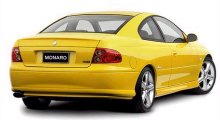 If
you expect a sportier handling and performance, you will be
disappointed.
The Monaro not only shares the same engines with Commodore, but the
suspension
setting is even softer than Commodore SS. It seems that Holden wants to
make it a comfortable tourer like 406 Coupe or 3-series Coupe, but then
again its semi-trailing arm suspensions prevent it from offering true
supple
and quiet ride quality. Strangely, steering ratio is tuned slower than
the sedan to make it more progressive and less nervous. Push the car
hard,
it is really more composed. It will understeer safely at the limit, it
will power slide under hard throttle, but something seemed missing:
agility
and sharpness. By coupe standard, it feels too big and heavy.
If
you expect a sportier handling and performance, you will be
disappointed.
The Monaro not only shares the same engines with Commodore, but the
suspension
setting is even softer than Commodore SS. It seems that Holden wants to
make it a comfortable tourer like 406 Coupe or 3-series Coupe, but then
again its semi-trailing arm suspensions prevent it from offering true
supple
and quiet ride quality. Strangely, steering ratio is tuned slower than
the sedan to make it more progressive and less nervous. Push the car
hard,
it is really more composed. It will understeer safely at the limit, it
will power slide under hard throttle, but something seemed missing:
agility
and sharpness. By coupe standard, it feels too big and heavy.
 The
conversion from Monaro to HSV Coupe is every bit predictable. Firstly,
HSV transplanted its 342hp version of the GM LS1 V8 into the Monaro
body.
It comes with the same 6-speed gearbox and limited slip differential as
a package. Then HSV replaced the Monaro’s slow and much-criticized
steering
rack with the original Commodore one, quickened steering response.
Stiffer
suspension setup, bigger brakes and a set of clothes designed by TWR
(HSV’s
mother company)’s Neil Simpson complete the package.
The
conversion from Monaro to HSV Coupe is every bit predictable. Firstly,
HSV transplanted its 342hp version of the GM LS1 V8 into the Monaro
body.
It comes with the same 6-speed gearbox and limited slip differential as
a package. Then HSV replaced the Monaro’s slow and much-criticized
steering
rack with the original Commodore one, quickened steering response.
Stiffer
suspension setup, bigger brakes and a set of clothes designed by TWR
(HSV’s
mother company)’s Neil Simpson complete the package.
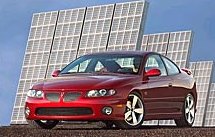 Pontiac
GTO is a moral victory to Australian motor industry. For decades,
Holden
relied on American design and technology from its parent company in
Detroit.
But time has changed. Today, General Motors can no longer build a
rear-drive
coupe as good and as cost-effectively as its Australian subsidiary.
While
GM was shutting the production line of its F-body cars (Pontiac
Firebird
and Chevrolet Camaro), Holden launched its first-ever self-developed
coupe,
Monaro. What a contrast.
Pontiac
GTO is a moral victory to Australian motor industry. For decades,
Holden
relied on American design and technology from its parent company in
Detroit.
But time has changed. Today, General Motors can no longer build a
rear-drive
coupe as good and as cost-effectively as its Australian subsidiary.
While
GM was shutting the production line of its F-body cars (Pontiac
Firebird
and Chevrolet Camaro), Holden launched its first-ever self-developed
coupe,
Monaro. What a contrast.
 In late 2004 Holden updated the
Monaro to VZ iteration. To observers, the most obvious change is the
additional air scoops over the bonnet. This modification was driven by
Pontiac GTO, whose fans complained that it lacked an aggressive
styling. In fact, they are pseudo scoops, drawing no air into the
engine compartment.
In late 2004 Holden updated the
Monaro to VZ iteration. To observers, the most obvious change is the
additional air scoops over the bonnet. This modification was driven by
Pontiac GTO, whose fans complained that it lacked an aggressive
styling. In fact, they are pseudo scoops, drawing no air into the
engine compartment. 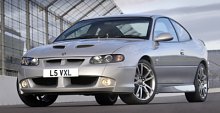 While
the standard Monaro uses the outgoing Corvette C5's 5.7-litre LS1 V8,
the HSV GTO and its European equivalent – Vauxhall Monaro VXR – employs
the latest C6's 6.0-litre LS2 engine. The engine produces about 403 SAE
horsepower or 409 DIN horsepower, and 391 lbft of torque. Both figures
are more or less the same as Chevrolet Corvette, implying HSV did only
the slightest revision to its ECU in order to comply with European
emission regulation. It powers the car from rest to 60 mph in less than
5 seconds and arrive 100 mph in 12 seconds. That's the territory of BMW
M3.
While
the standard Monaro uses the outgoing Corvette C5's 5.7-litre LS1 V8,
the HSV GTO and its European equivalent – Vauxhall Monaro VXR – employs
the latest C6's 6.0-litre LS2 engine. The engine produces about 403 SAE
horsepower or 409 DIN horsepower, and 391 lbft of torque. Both figures
are more or less the same as Chevrolet Corvette, implying HSV did only
the slightest revision to its ECU in order to comply with European
emission regulation. It powers the car from rest to 60 mph in less than
5 seconds and arrive 100 mph in 12 seconds. That's the territory of BMW
M3.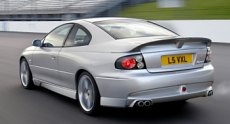 The
chassis has sportier tuning than the standard Monaro of course, such as
stiffer suspension setup, quicker steering, bigger brakes, 19-inch
alloy wheels (compare to 18-in), wider and lower profile tires. On
demanding roads, the GTO has none of the bulky feel as the standard
Monaro. It belies its size very well, capable to attack B-roads like
BMW M3. It suspensions have enough compliance to deal with B-roads
while maintaining body control excellent. Its steering is full of feel,
once again proving the Commodore chassis is fundamentally so right.
The
chassis has sportier tuning than the standard Monaro of course, such as
stiffer suspension setup, quicker steering, bigger brakes, 19-inch
alloy wheels (compare to 18-in), wider and lower profile tires. On
demanding roads, the GTO has none of the bulky feel as the standard
Monaro. It belies its size very well, capable to attack B-roads like
BMW M3. It suspensions have enough compliance to deal with B-roads
while maintaining body control excellent. Its steering is full of feel,
once again proving the Commodore chassis is fundamentally so right.  The 2004
Pontiac GTO was selling disappointingly in the USA, putting Bob Lutz in
embarrassment (and eventually lost his post as the boss of GM North
America). People criticized the Australian-built coupe for looking too
civilized. More excitement must be injected to save it from
termination. Therefore the 2005 GTO has got a new bonnet with a pair of
pseudo air scoops, more pronounced chin spoiler, side skirts and rear
spoiler. Overall, it looks slightly more aggressive than the past, but
probably not enough for the American's taste, especially it is now
facing the stylish new Mustang. It should have copied the aggressive
bumper intakes from HSV.
The 2004
Pontiac GTO was selling disappointingly in the USA, putting Bob Lutz in
embarrassment (and eventually lost his post as the boss of GM North
America). People criticized the Australian-built coupe for looking too
civilized. More excitement must be injected to save it from
termination. Therefore the 2005 GTO has got a new bonnet with a pair of
pseudo air scoops, more pronounced chin spoiler, side skirts and rear
spoiler. Overall, it looks slightly more aggressive than the past, but
probably not enough for the American's taste, especially it is now
facing the stylish new Mustang. It should have copied the aggressive
bumper intakes from HSV.